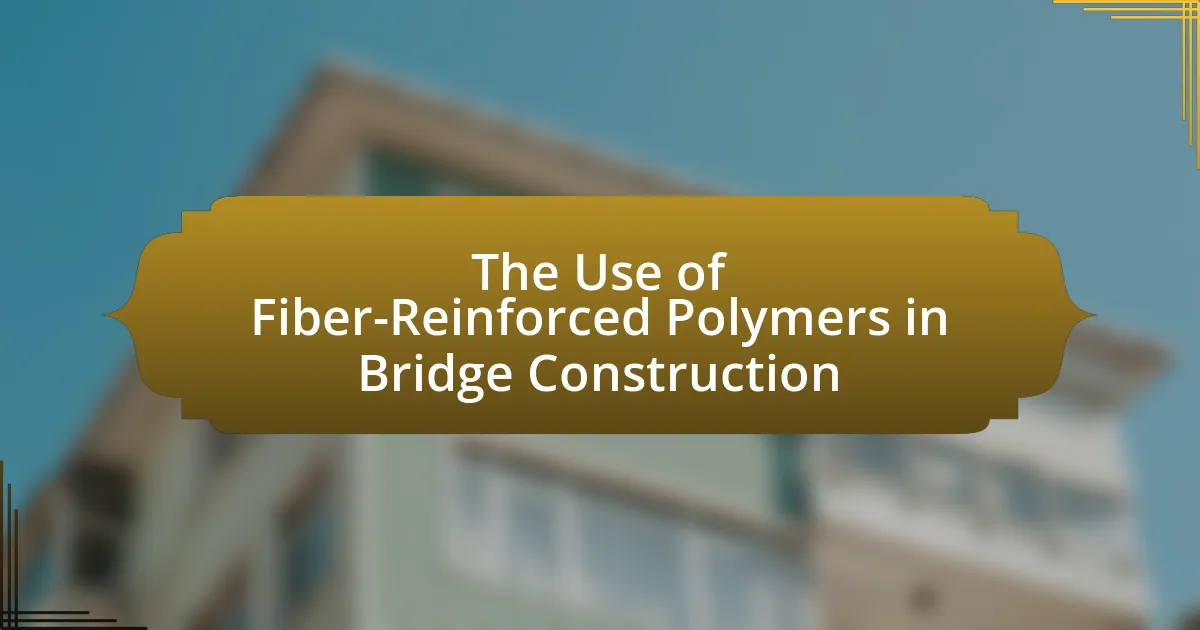Fiber-Reinforced Polymers (FRPs) are composite materials utilized in bridge construction, known for their high strength-to-weight ratios, corrosion resistance, and durability. This article explores the advantages of FRPs over traditional materials, detailing their key components, applications in various bridge components, and the role they play in enhancing structural integrity and longevity. It also addresses challenges associated with their use, such as initial costs and environmental susceptibility, while highlighting future trends and best practices for effective implementation in bridge engineering. The discussion emphasizes the growing adoption of FRPs in modern infrastructure due to their performance benefits and sustainability potential.

What are Fiber-Reinforced Polymers and their Role in Bridge Construction?
Fiber-Reinforced Polymers (FRPs) are composite materials made of a polymer matrix reinforced with fibers, typically glass, carbon, or aramid, which enhance their mechanical properties. In bridge construction, FRPs play a crucial role by providing high strength-to-weight ratios, corrosion resistance, and durability, which are essential for extending the lifespan of structures. For instance, studies have shown that using FRP in bridge decks can reduce overall weight by up to 75% compared to traditional materials, leading to lower transportation and installation costs. Additionally, FRPs are resistant to environmental factors, which minimizes maintenance needs and enhances safety, making them an increasingly popular choice in modern engineering applications.
How do Fiber-Reinforced Polymers differ from traditional materials?
Fiber-Reinforced Polymers (FRPs) differ from traditional materials primarily in their enhanced strength-to-weight ratio and corrosion resistance. Unlike traditional materials such as steel and concrete, which are heavy and susceptible to environmental degradation, FRPs are lightweight and exhibit superior durability, making them ideal for applications in bridge construction. For instance, FRPs can be up to five times lighter than steel while maintaining comparable strength, which reduces the overall load on bridge structures and allows for easier handling and installation. Additionally, FRPs are resistant to moisture, chemicals, and UV radiation, which significantly extends the lifespan of bridge components compared to traditional materials that may corrode or deteriorate over time.
What are the key components of Fiber-Reinforced Polymers?
The key components of Fiber-Reinforced Polymers (FRPs) are the polymer matrix and the reinforcing fibers. The polymer matrix, typically made from thermosetting or thermoplastic resins, provides the structural integrity and binds the fibers together. The reinforcing fibers, which can be made from materials such as glass, carbon, or aramid, enhance the mechanical properties of the composite, including strength and stiffness. This combination allows FRPs to exhibit superior performance characteristics, making them suitable for applications like bridge construction, where durability and lightweight properties are essential.
How do the properties of Fiber-Reinforced Polymers enhance bridge construction?
Fiber-Reinforced Polymers (FRPs) enhance bridge construction through their high strength-to-weight ratio, corrosion resistance, and design flexibility. These properties allow for lighter structures that require less support, reducing the overall load on foundations and enabling longer spans. Additionally, FRPs are resistant to environmental degradation, which extends the lifespan of bridges and minimizes maintenance costs. Studies have shown that bridges constructed with FRPs can withstand harsh conditions better than traditional materials, leading to improved durability and safety.
Why is the use of Fiber-Reinforced Polymers increasing in bridge construction?
The use of Fiber-Reinforced Polymers (FRPs) is increasing in bridge construction due to their superior strength-to-weight ratio and corrosion resistance. These materials provide significant advantages over traditional construction materials like steel and concrete, particularly in environments prone to moisture and chemical exposure. For instance, FRPs can reduce the overall weight of bridge components, leading to easier handling and installation, while their resistance to corrosion extends the lifespan of bridges, reducing maintenance costs. Studies have shown that bridges constructed with FRPs can last significantly longer than those made with conventional materials, with some estimates indicating a lifespan increase of up to 50 years.
What advantages do Fiber-Reinforced Polymers offer over conventional materials?
Fiber-Reinforced Polymers (FRPs) offer significant advantages over conventional materials such as steel and concrete, primarily due to their high strength-to-weight ratio, corrosion resistance, and design flexibility. The high strength-to-weight ratio allows for lighter structures, which can reduce the overall load on bridge foundations and support systems. Corrosion resistance is crucial in bridge construction, as FRPs do not rust or degrade in harsh environmental conditions, leading to lower maintenance costs and longer service life. Additionally, the design flexibility of FRPs enables the creation of complex shapes and forms that are not feasible with traditional materials, enhancing aesthetic and functional aspects of bridge design. These advantages are supported by studies indicating that FRPs can outperform conventional materials in terms of durability and lifecycle costs, making them a preferred choice in modern bridge construction.
How do environmental factors influence the adoption of Fiber-Reinforced Polymers?
Environmental factors significantly influence the adoption of Fiber-Reinforced Polymers (FRPs) in bridge construction by affecting material performance, durability, and cost-effectiveness. For instance, exposure to moisture, temperature fluctuations, and UV radiation can degrade traditional materials, making FRPs, which offer superior resistance to corrosion and environmental degradation, more appealing. Studies have shown that FRPs can maintain structural integrity in harsh environments, such as coastal areas with high salinity, where steel reinforcement would typically suffer from corrosion. Additionally, the lightweight nature of FRPs allows for easier handling and installation in various environmental conditions, further promoting their adoption in bridge projects.

What are the specific applications of Fiber-Reinforced Polymers in bridge construction?
Fiber-Reinforced Polymers (FRPs) are specifically applied in bridge construction for strengthening, retrofitting, and constructing new bridge components. These materials enhance the load-bearing capacity and durability of bridges while reducing weight compared to traditional materials. For instance, FRPs are utilized in the reinforcement of concrete beams and slabs, providing improved tensile strength and resistance to environmental degradation. Additionally, FRP composites are employed in the fabrication of bridge decks and girders, which can lead to longer spans and reduced maintenance costs. The use of FRPs also allows for the construction of lightweight structures that are easier to transport and install, thereby expediting the construction process.
How are Fiber-Reinforced Polymers utilized in different bridge components?
Fiber-Reinforced Polymers (FRPs) are utilized in various bridge components such as decks, beams, and reinforcement systems. In bridge decks, FRPs provide lightweight, corrosion-resistant surfaces that enhance durability and reduce maintenance costs. For beams, FRPs are employed to improve load-bearing capacity while minimizing weight, which is crucial for long-span bridges. Additionally, FRPs are used in reinforcement systems to strengthen existing structures, offering a non-invasive solution that prolongs the lifespan of bridges. The effectiveness of FRPs in these applications is supported by their high strength-to-weight ratio and resistance to environmental degradation, making them a preferred choice in modern bridge construction.
What role do Fiber-Reinforced Polymers play in bridge decks?
Fiber-Reinforced Polymers (FRPs) enhance the structural performance and durability of bridge decks. They provide high strength-to-weight ratios, corrosion resistance, and reduced maintenance needs, which contribute to longer service life and lower lifecycle costs. Studies have shown that incorporating FRPs in bridge deck construction can improve load-bearing capacity and reduce the overall weight of the structure, leading to more efficient designs. For instance, research published in the “Journal of Composites for Construction” indicates that FRP-reinforced bridge decks exhibit superior fatigue resistance compared to traditional materials, thereby ensuring safety and longevity in bridge applications.
How are Fiber-Reinforced Polymers used in bridge reinforcement?
Fiber-Reinforced Polymers (FRPs) are used in bridge reinforcement primarily to enhance structural integrity and extend service life. FRPs, composed of a polymer matrix reinforced with fibers such as glass or carbon, provide high strength-to-weight ratios and excellent corrosion resistance, making them ideal for reinforcing existing bridge structures or constructing new ones. Studies have shown that the application of FRPs can significantly improve load-bearing capacity and reduce maintenance costs, as they are less susceptible to environmental degradation compared to traditional materials like steel. For instance, research published in the Journal of Composites for Construction indicates that bridges reinforced with FRPs exhibit improved durability and performance under various loading conditions, validating their effectiveness in modern bridge engineering.
What are the challenges associated with using Fiber-Reinforced Polymers in bridge construction?
The challenges associated with using Fiber-Reinforced Polymers (FRPs) in bridge construction include high initial costs, limited long-term performance data, and susceptibility to environmental degradation. High initial costs arise from the materials and specialized labor required for installation, which can deter widespread adoption. Limited long-term performance data is a concern because many FRP materials have not been in service long enough to fully understand their durability and maintenance needs. Additionally, FRPs can be susceptible to ultraviolet light and moisture, leading to potential degradation over time, which raises questions about their longevity in various environmental conditions. These factors collectively hinder the broader implementation of FRPs in bridge construction projects.
What are the common misconceptions about Fiber-Reinforced Polymers?
Common misconceptions about Fiber-Reinforced Polymers (FRPs) include the belief that they are not as strong as traditional materials like steel and concrete, and that they are too expensive for widespread use. In reality, FRPs can offer comparable or superior strength-to-weight ratios, making them suitable for various structural applications, including bridge construction. Additionally, while the initial cost of FRPs may be higher, their long-term durability and reduced maintenance needs can lead to overall cost savings. Studies have shown that FRPs can withstand harsh environmental conditions better than traditional materials, further validating their effectiveness in infrastructure projects.
How can the challenges of using Fiber-Reinforced Polymers be addressed?
The challenges of using Fiber-Reinforced Polymers (FRPs) can be addressed through improved material formulations, enhanced design methodologies, and rigorous testing protocols. By developing advanced resin systems and optimizing fiber types, manufacturers can increase the durability and performance of FRPs, making them more suitable for bridge construction. Additionally, implementing design guidelines that account for the unique properties of FRPs, such as their anisotropic behavior, can lead to more effective structural applications. Finally, conducting comprehensive testing to evaluate long-term performance under various environmental conditions ensures that FRPs meet safety and reliability standards, as evidenced by studies showing that properly tested FRP components can outperform traditional materials in specific applications.

What are the future trends in the use of Fiber-Reinforced Polymers for bridges?
Future trends in the use of Fiber-Reinforced Polymers (FRPs) for bridges include increased adoption due to their lightweight properties, corrosion resistance, and design flexibility. As infrastructure ages and the need for durable materials rises, FRPs are expected to play a significant role in bridge rehabilitation and new constructions. Research indicates that the global FRP market is projected to grow at a compound annual growth rate of over 10% from 2021 to 2028, driven by advancements in manufacturing techniques and material properties. Additionally, the integration of smart technologies into FRP systems for real-time monitoring and maintenance is anticipated to enhance their application in bridge engineering.
How is technology advancing the use of Fiber-Reinforced Polymers in bridge construction?
Technology is advancing the use of Fiber-Reinforced Polymers (FRPs) in bridge construction through innovations in material science, manufacturing processes, and structural design. Advanced manufacturing techniques, such as automated fiber placement and 3D printing, enable the production of complex FRP components with high precision and reduced labor costs. Additionally, the integration of sensors and smart technologies into FRP materials allows for real-time monitoring of structural health, enhancing safety and longevity. Research indicates that FRPs can reduce the weight of bridge components by up to 75% compared to traditional materials, leading to lower transportation and installation costs. Furthermore, the development of hybrid materials that combine FRPs with other composites enhances mechanical properties, making them suitable for a wider range of applications in bridge construction.
What innovations are being developed for Fiber-Reinforced Polymers?
Innovations being developed for Fiber-Reinforced Polymers (FRPs) include advancements in hybrid materials, self-sensing capabilities, and improved manufacturing techniques. Hybrid materials combine different types of fibers, such as carbon and glass, to enhance mechanical properties and reduce costs. Self-sensing FRPs integrate sensors that monitor structural health in real-time, allowing for proactive maintenance and safety assessments. Additionally, advancements in manufacturing techniques, such as 3D printing and automated fiber placement, are streamlining production processes and enabling more complex geometries. These innovations are supported by ongoing research, such as studies published in the Journal of Composite Materials, which highlight the effectiveness of these new approaches in enhancing the performance and application of FRPs in bridge construction.
How might sustainability influence future applications of Fiber-Reinforced Polymers?
Sustainability will significantly influence future applications of Fiber-Reinforced Polymers (FRPs) by driving the development of eco-friendly materials and manufacturing processes. As environmental regulations become stricter and the demand for sustainable construction practices increases, the focus will shift towards using renewable resources and recyclable materials in FRP production. For instance, bio-based fibers and resins are being explored to reduce the carbon footprint associated with traditional petroleum-based polymers. Additionally, the durability and low maintenance requirements of FRPs align with sustainability goals by extending the lifespan of structures, thereby reducing the need for frequent repairs and replacements. This trend is supported by research indicating that the use of FRPs can lead to a reduction in overall lifecycle costs and environmental impact in construction projects.
What best practices should be followed when using Fiber-Reinforced Polymers in bridge construction?
Best practices for using Fiber-Reinforced Polymers (FRPs) in bridge construction include thorough material selection, proper design integration, and adherence to installation guidelines. Selecting high-quality FRP materials that meet specific structural requirements ensures durability and performance. Integrating FRPs into the design phase allows for optimized load distribution and structural efficiency. Following manufacturer installation guidelines is crucial to maintain the integrity of the materials and ensure proper bonding with other construction elements. Additionally, conducting regular inspections and maintenance can help identify potential issues early, thereby extending the lifespan of the bridge. These practices are supported by studies indicating that proper implementation of FRPs can enhance the longevity and safety of bridge structures.
How can engineers ensure the longevity of bridges constructed with Fiber-Reinforced Polymers?
Engineers can ensure the longevity of bridges constructed with Fiber-Reinforced Polymers (FRPs) by implementing rigorous design standards, regular maintenance, and environmental protection measures. The use of high-quality materials and adherence to established guidelines, such as those from the American Concrete Institute, can significantly enhance durability. Additionally, incorporating protective coatings can mitigate the effects of moisture and UV exposure, which are known to degrade polymer materials over time. Research indicates that FRP composites exhibit superior resistance to corrosion compared to traditional materials, thus extending the lifespan of structures. Regular inspections and timely repairs further contribute to maintaining the integrity and performance of FRP bridges.
What maintenance strategies are effective for Fiber-Reinforced Polymer bridges?
Effective maintenance strategies for Fiber-Reinforced Polymer (FRP) bridges include regular visual inspections, non-destructive testing, and environmental monitoring. Regular visual inspections help identify surface damage, delamination, or signs of wear, which are critical for maintaining structural integrity. Non-destructive testing methods, such as ultrasonic testing and thermography, allow for the assessment of internal defects without damaging the material. Environmental monitoring is essential to track exposure to moisture, temperature fluctuations, and chemical agents that could affect the longevity of FRP materials. These strategies are supported by studies indicating that proactive maintenance can extend the lifespan of FRP bridges significantly, with some research showing that timely interventions can reduce repair costs by up to 30%.

Leave a Reply